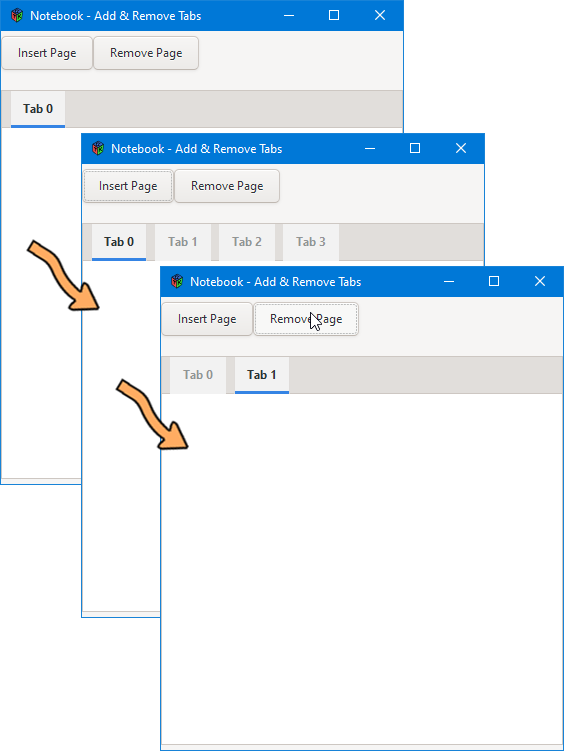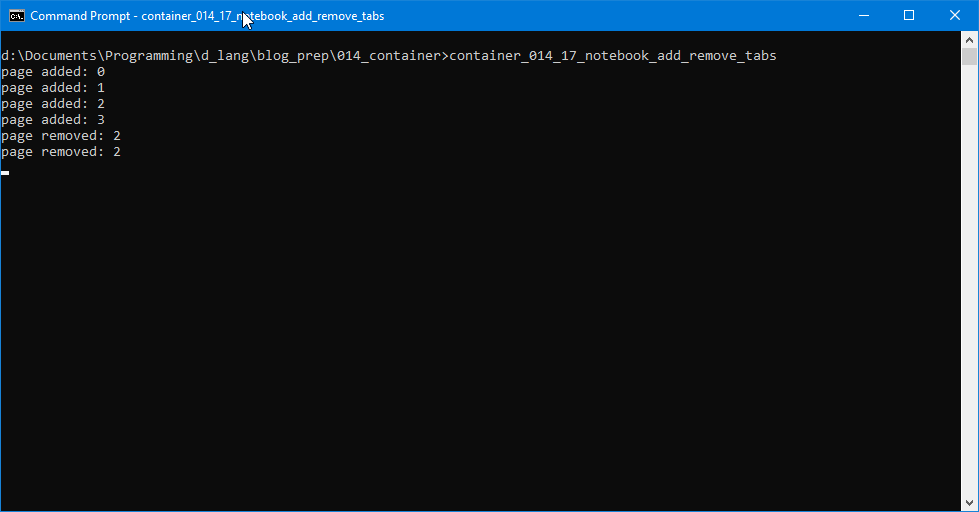0082: Notebook VI – Adding and Removing Tabs
Today we’re going to cover adding and deleting tabs and I’ll talk a bit about how a GTK Notebook keeps track of tabs, why you don’t have to, and why you might think you do.
Rather than building a menu system for this, I decided it would be less work to just toss in a couple of Buttons… and it was.


A Grid for Buttons
We’ll use a Grid derivative to hold the Button widgets:
class ButtonGrid : Grid
{
InsertButton insertButton;
RemoveButton removeButton;
this(MyNotebook myNotebook)
{
insertButton = new InsertButton(myNotebook);
attach(insertButton, 0, 0, 1, 1);
removeButton = new RemoveButton(myNotebook);
attach(removeButton, 1, 0, 1, 1);
} // this()
} // class ButtonGrid
Nothing new here, just a quick refresher on how to stuff things into a Grid. Create a couple of Button widgets and attach(), remembering that those arguments mean:
- first arg (
0): the column to start in, - second arg (
0): the row to start in, - third arg (
1): number of columns this widget takes up, and - fourth arg (
1): number of rows this widget takes up.
The only thing of real note here is that a pointer to the Notebook is passed into the Grid and subsequently passed along to each Button that’s created. We’ll cover the particulars of why next as we look at…
A Button for Inserting Tabs
We’ve seen these buttons before, so no new ground is being covered. Even the fact that we’re passing in a pointer to the Notebook is something we’ve seen before in the GTK Menu series (Blog Post #34: AccelGroup as a Singleton) where we Singleton-ized our AccelGroup so we could tap into it from wherever without passing it down through multiple layers of objects. But this time, for simplicity sake and because there are only two levels to deal with, we’ll do it the non-Singleton way:
class InsertButton : Button
{
string _buttonLabel = "Insert Page";
TabTextView myTextView;
MyNotebook _myNotebook;
this(MyNotebook myNotebook)
{
super(_buttonLabel);
_myNotebook = myNotebook;
addOnClicked(&onClicked);
} // this()
void onClicked(Button button)
{
_myNotebook.addPage();
} // onClicked()
} // class InsertButton
And why do we need the Notebook pointer in here? Because the Insert Page and Remove Page Buttons need access to the MyNotebook.addPage() and MyNotebook.deletePage() functions, respectively.
And when we hook up the signals, because we’ve got a local copy of the MyNotebook pointer (_myNotebook) it’s dead simple to make the calls.
The Remove Page Button is set up exactly the same way, so let’s now look at the changes in MyNotebook…
MyNotebook – What’s New?
There are some pretty drastic changes in this class, so let’s look at them by section…
The Preamble
CSS css; // needed to see tab shapes against the bg
PositionType tabPosition = PositionType.TOP;
string tabLabelPrefix = "Tab ";
int _lastPageNumber = -1;
Here, we got rid of all the declarations for TextView and Label objects and replaced them with a single string (tabLabelPrefix) which we’ll use to build tab Labels each time addPage() is called.
We also have a completely new addition in _lastPageNumber. This will help make sure each new tab gets a unique name. This isn’t strictly necessary for a full-blown application, but I have seen it done. For our purposes, it will mainly serve to tell us which tab is being removed or what the new order of the tabs is… because we’re also keeping that reordering functionality we talked about last time.
And why is it initially set to -1? Because if we’re being purists, all arrays start at 0 and that leads me to a slight digression…
How the GTK Notebook Handles Tabs/Pages and Why it Might Not be Obvious
Each time you make a call to Notebook.appendPage(), it returns an integer commonly referred to in the API docs as an index or tabIndex. The fact that this number is returned might lead you to believe that you have to track the array of tabs, but don’t be fooled. It does keep a running tally—each subsequent call to appendPage() increases the index returned by this function—but my guess is this is a leftover from a time when you actually did have to keep track of the tab array.
This is why, in all the demo code I’ve written for the Notebook, I ignore the appendPage() return value. I couldn’t think of anything useful to do with the index, so I ignored it, but if you come up with something, I’d love to hear about it.
Now, back to our show…
The Constructor
This is short and sweet:
this()
{
super();
setTabPos(tabPosition);
css = new CSS(getStyleContext());
addPage();
} // this()
Here’s what we do:
- call the super-class constructor,
- set up where the tabs will appear in relation to the
Notebookwork area, - associate our
CSSso we have tabs with colored backgrounds, and - add the first tab/page.
I threw in that last line to mimic what most text editors do, give you a new, blank page to work with on start-up so you don’t have to monkey around with New as soon as you’ve started your app.
The addPage() Function
void addPage()
{
_lastPageNumber++; // increase the page count
TabTextView tabTextView = new TabTextView();
Label label = new Label("Tab " ~ _lastPageNumber.to!string());
appendPage(tabTextView, label);
setTabReorderable(tabTextView, true);
showAll();
} // addPage()
This is all straightforward:
- increment the page count variable to ensure a unique tab name,
- instantiate a
TabTextViewand aLabel, - append the page, and
- turn on the reorderable flag.
That last line, showAll(), is important because with all these widgets we’re juggling, the Notebook needs a kick in the butt to do a redraw.
A Note About Page Count and the tabIndex
You might think that the value returned from appendPage() could be used in place of _lastPageNumber, but here’s the thing… for our purposes, we need the new page to be created with its label containing the number that’s returned by appendPage(). In other words, we need the number before appendPage() can give it to us. And that’s why this one thing, the numbering used in tab labels, is something we have to track ourselves.
Conclusion
And so we come to the end of another post dedicated to the Notebook. And next time, a look at all the signals you might deal with in—yup—a Notebook.
Until then, happy coding.
Comments? Questions? Observations?
Did we miss a tidbit of information that would make this post even more informative? Let's talk about it in the comments.
- come on over to the D Language Forum and look for one of the gtkDcoding announcement posts,
- drop by the GtkD Forum,
- follow the link below to email me, or
- go to the gtkDcoding Facebook page.
You can also subscribe via RSS so you won't miss anything. Thank you very much for dropping by.
© Copyright 2025 Ron Tarrant
